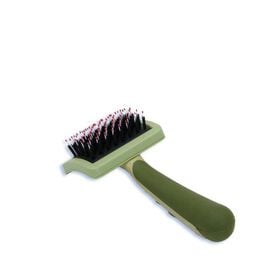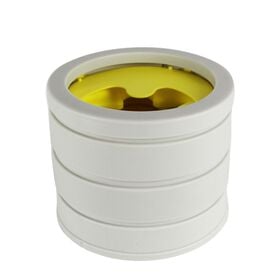It’s hard not to smile when meeting a Selkirk rex for the first time. Its permanently tousled appearance makes it look like it’s been hanging on the clothesline all night. For the Selkirk rex, every day’s a bad hair day! When you take a closer look, however, you get an irresistible urge to bury your hands in its thick, curly coat similar to a woolly sheep, or to squeeze it like the stuffed toys of your childhood. Imagine getting the chance to adopt one!
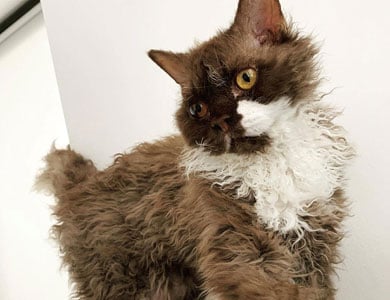
Monsieur, the selkirk rex in Mondou’s big family.
Photo credit: Audrey Richer
Morphology and appearance
It’s a cat that is fairly large, muscular and with heavy boning. Its head is round and its muzzle, twice as wide as it is long, is never too flat. Its rounded ears are not too big or too small, and its large round eyes complete its Teddy bear appearance.
It comes in 2 varieties: shorthair and longhair. In both cases, the hair is curly, with a dense undercoat that is also curly. Even the whiskers are curly, but tend to break off easily. Regardless of coat length, the curls are most prominent on the neck, belly and flanks. The coat of the shorthair veriety is more plush, dense and uniform, resembling the texture of a Teddy bear. Longhairs look more like woolly sheep, with looser curls and a more ruffled appearance. Both shorthairs and longhairs come in all colours.
During the cat’s lifetime and depending on hormones, its coat can vary in appearance. Kittens are born all curly, from whiskers to the tip of their tail. The hair then fluctuates in appearance until about age 1. When these cats reach adulthood, hormones cause the curls to change. Intact and castrated males, and sterilized females have the nicest curls. Reproductive females lose their curls when they are in heat, and during gestation and lactation, after which the curls may or may not come back. Only the whiskers remain curly.
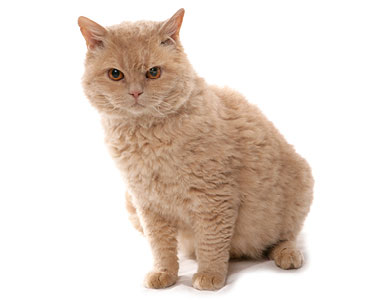
Behaviour
Selkirk rex are easy-going, level-tempered cats. They generally adapt easily to their family, and tolerate dogs, children and other cats, as long as they are given time to get used to them. Although they enjoy quiet time on the sofa with humans, they also like to run around and chase their toys. Like all cats, they seek out heights, so a good cat tree is an excellent investment. These cats are curious and intelligent, and enjoy participating in family life, learning new tricks and occupying themselves with their toys and interactive bowls to get treats.
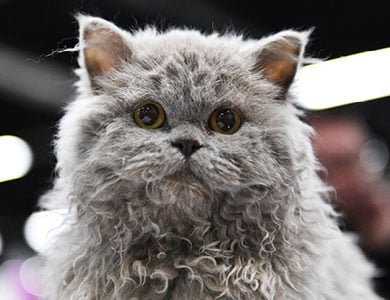
Level of maintenance (grooming)
Contrary to what you might think, the Selkirk rex does not require too much maintenance. Running a comb through its curls once or twice a week is usually enough to keep knots from forming. More frequent brushing may be necessary during shedding seasons, but keep in mind that over-grooming will loosen the curl. Pay special attention to the ears, which are prone to wax build-up, and the eyes, which tend to be runny. Ask your veterinarian how to clean your cat’s ears and eyes. Most of the time, all you need is a clean, dry cloth to remove any traces of dirt.
Like other cats, Selkirk rex need to have their claws and teeth cared for. In addition to providing a scratching post, trimming their claws regularly with a good nail clipper will prevent unpleasant scratches. Daily toothbrushing with special toothpaste will help promote good oral health. In all cases, desensitization from an early age combined with positive reinforcement will help make handling your cat as pleasant as a petting session, for both you and your pet.
What about baths? Most cats would say that they’re better off without them. However, Selkirk rex are prone to a greasy coat and can benefit from a shampooing to help control the skin’s production of sebum. You may want to start by having the cat examined by your veterinarian to make sure it doesn’t have an underlying medical condition. Take advantage of the visit to ask about what shampoo to use and head over to see our in-store advisor to get what you need.
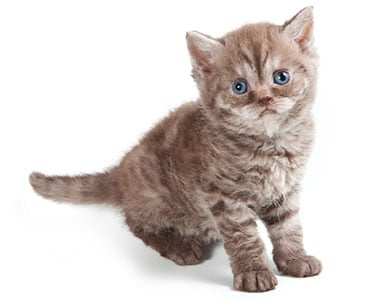
Origins
In 1987, a Persian cat breeder from Montana, Jeri Newman, rescued a stray cat with a unique coat. The small stray resembled a woolly sheep. Newman named her “Miss DePesto of No Face”. Curious about whether she could reproduce this unique coat, Newman mated her with her black Persian male named “Ch. Photo Finish of Deekay”. Six months later, the cat gave birth to a litter of six kittens, half of which were as curly as their mother. The genetic mutation responsible for the curly hair was dominant and different from other known curly-coated cats. All the conditions came together, and a new breed was born. Newman named the breed “Selkirk rex,” although it is unclear whether this was as a tribute to her stepfather or the nearby Selkirk Mountains, where the cat was found.
All Selkirk rex are descendants of "Miss DePesto of No Face". To obtain a healthy gene pool, Selkirks were crossed mainly with Persians and British shorthairs, but also with American shorthairs, exotic shorthairs and Himalayans. Since the Selkirk's characteristic gene is dominant, the morphology of the breed stabilized quickly. Still today, Persians and British shorthairs appear in the Selkirk's recent family tree.
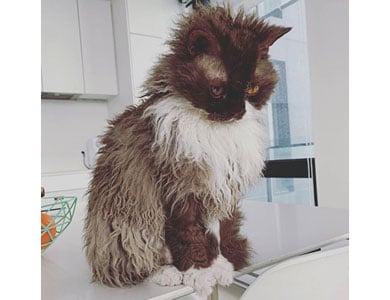
Monsieur, the selkirk rex in Mondou’s big family.
Photo credit: Audrey Richer
Unusual facts
The genetic mutation responsible for the Selkirk's curly hair is very different from that of the Cornish rex and the Devon rex, which have recessive genes. The Selkirk’s gene mutation is the result of an incomplete dominant gene. This means that the mutation does not have to be on the two alleles of the gene to occur, but also that the mutation will manifest differently depending on whether it is on one or both alleles.


